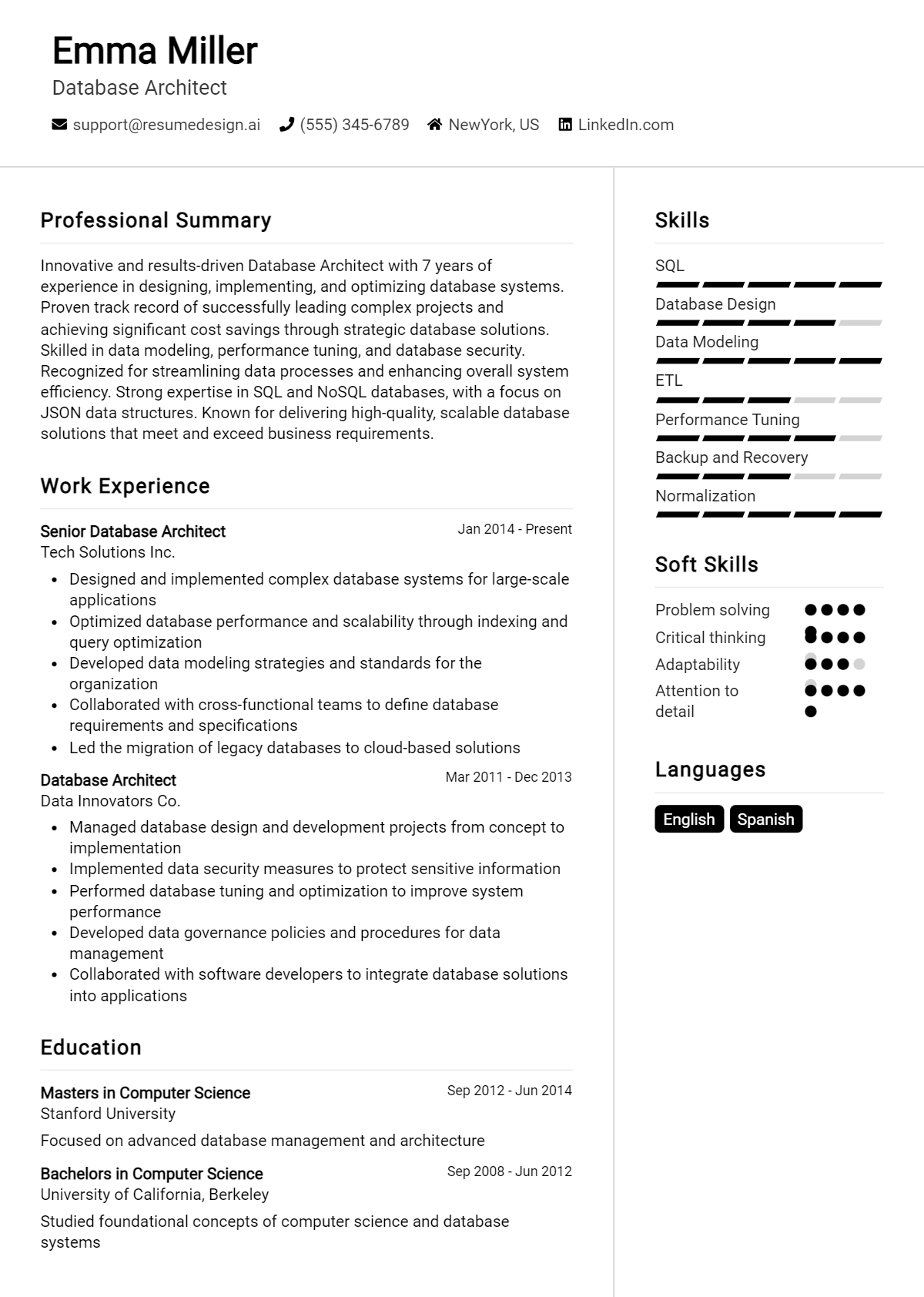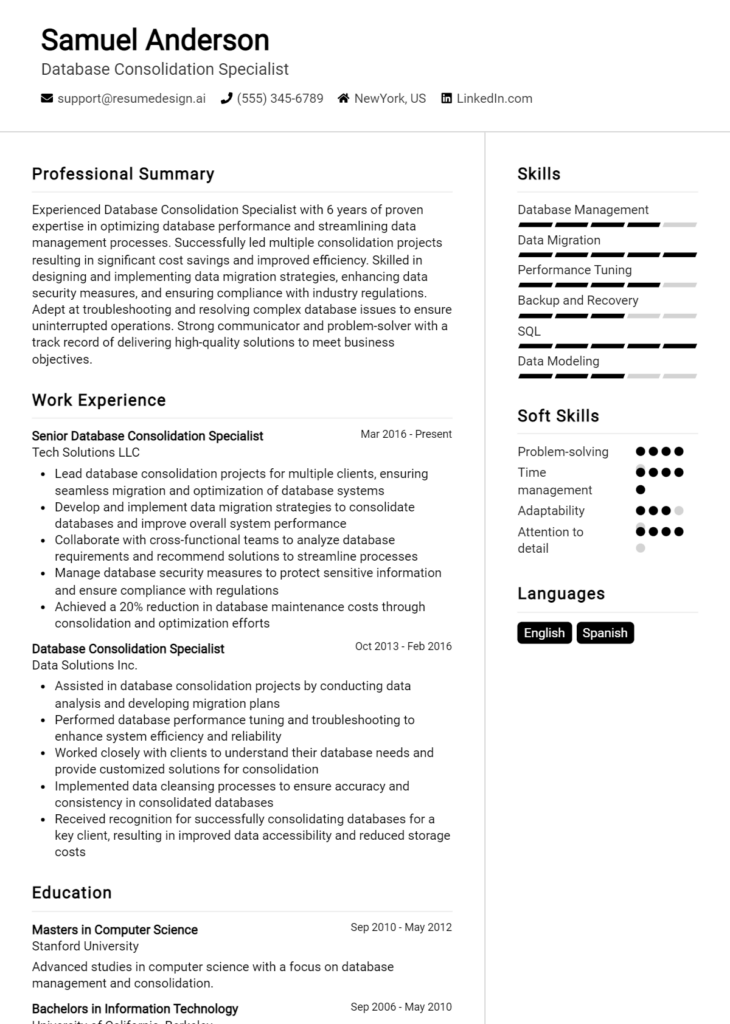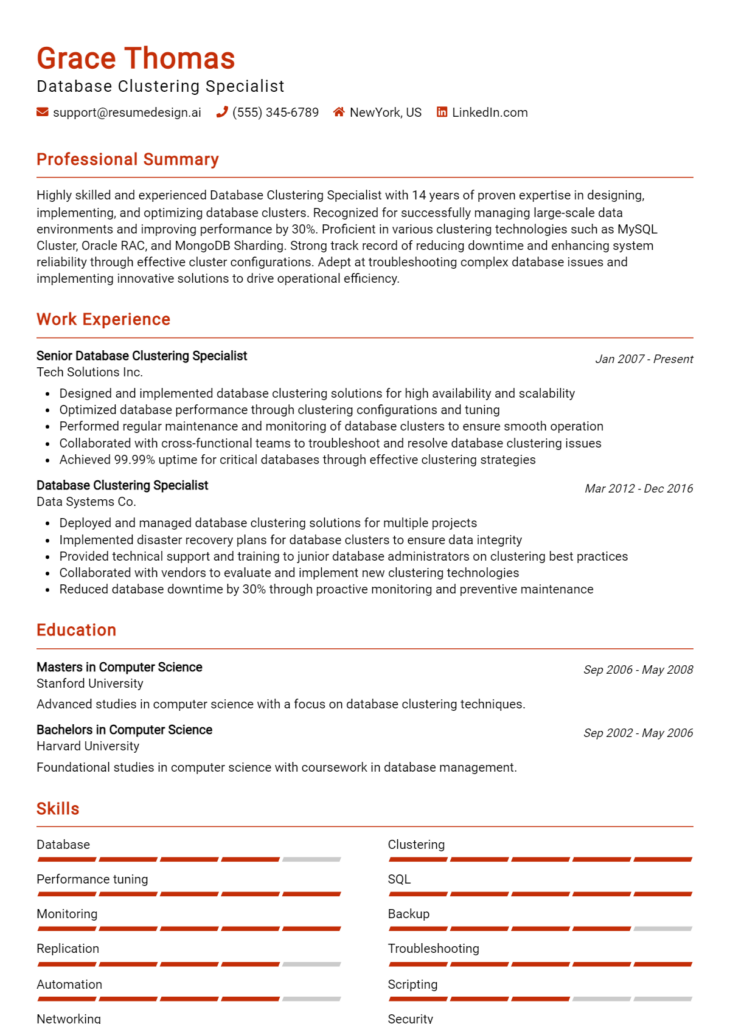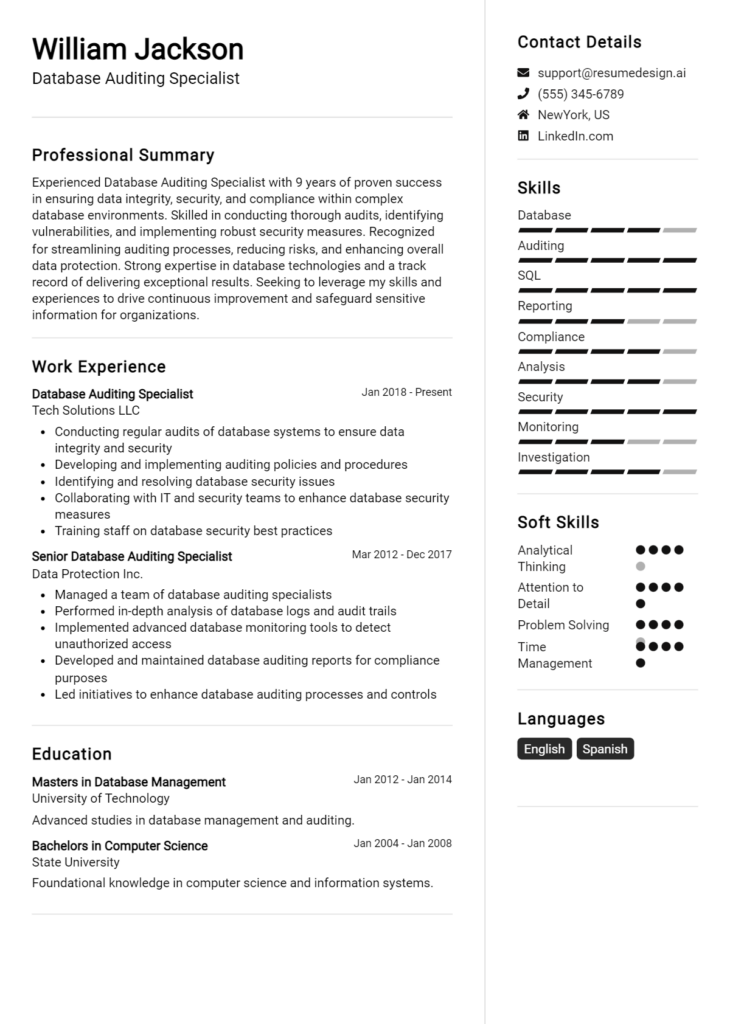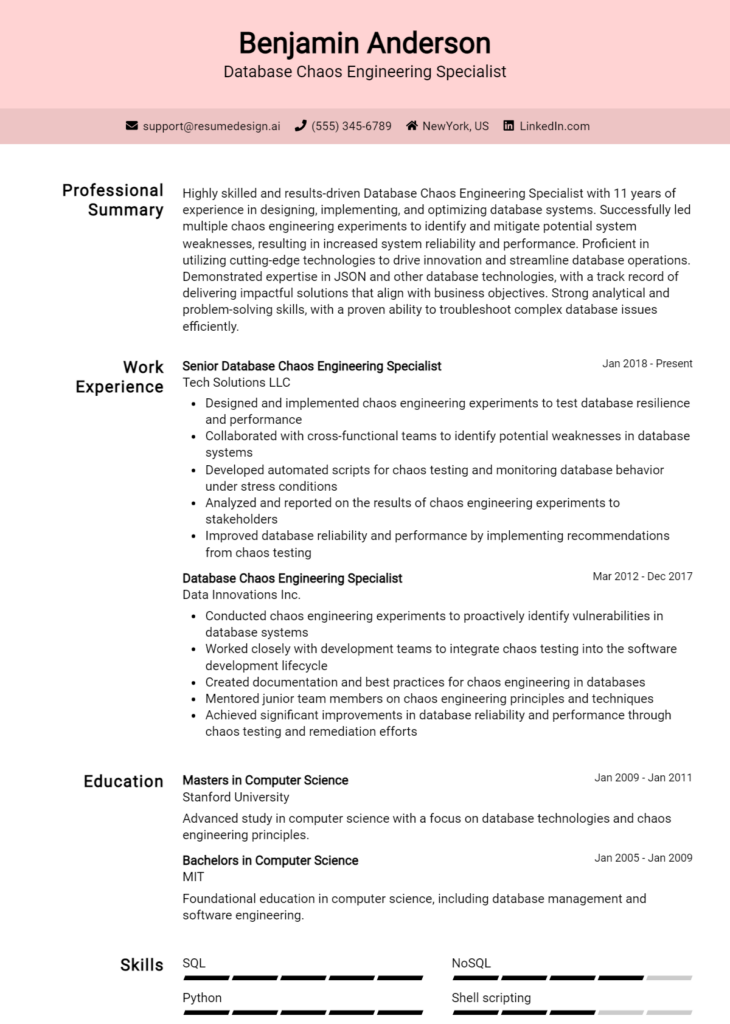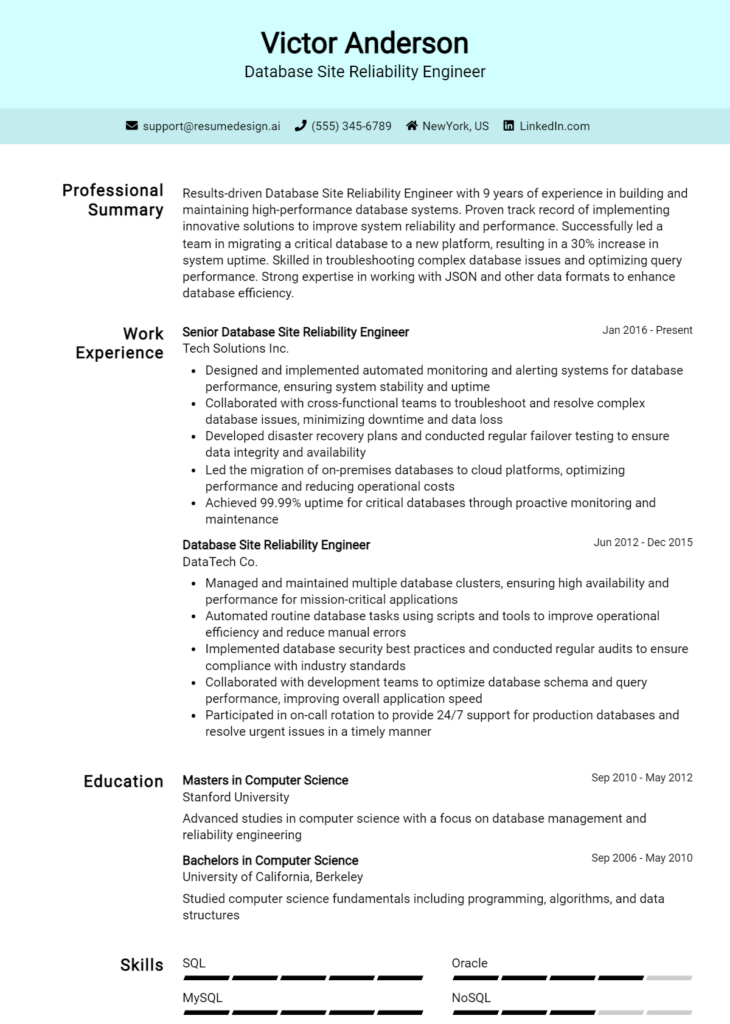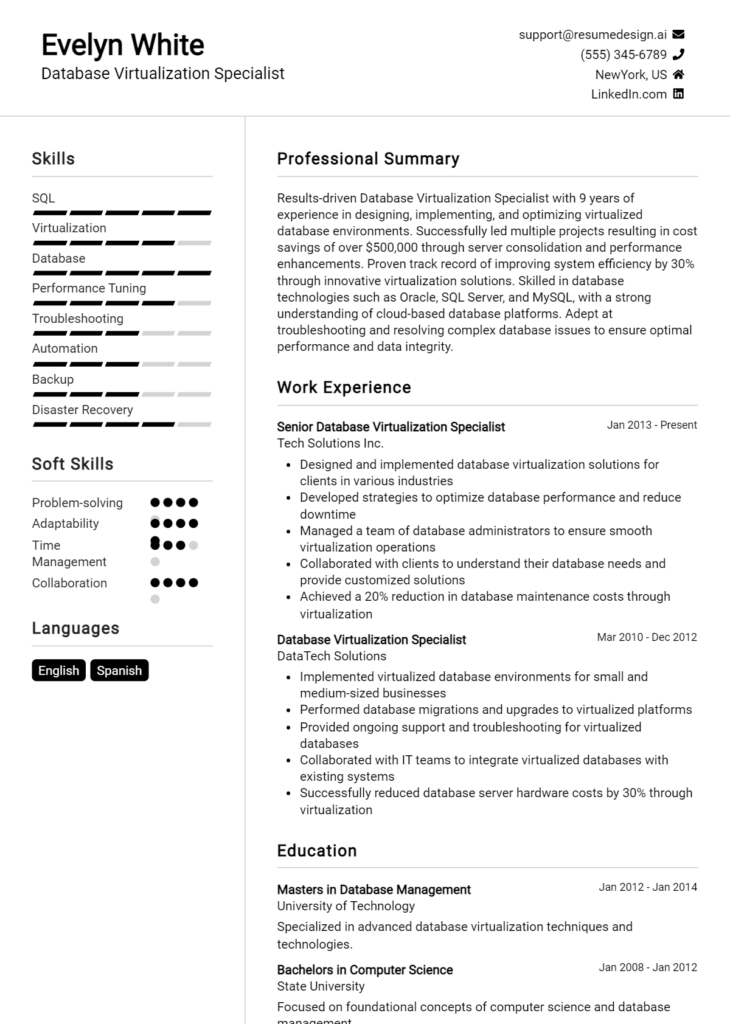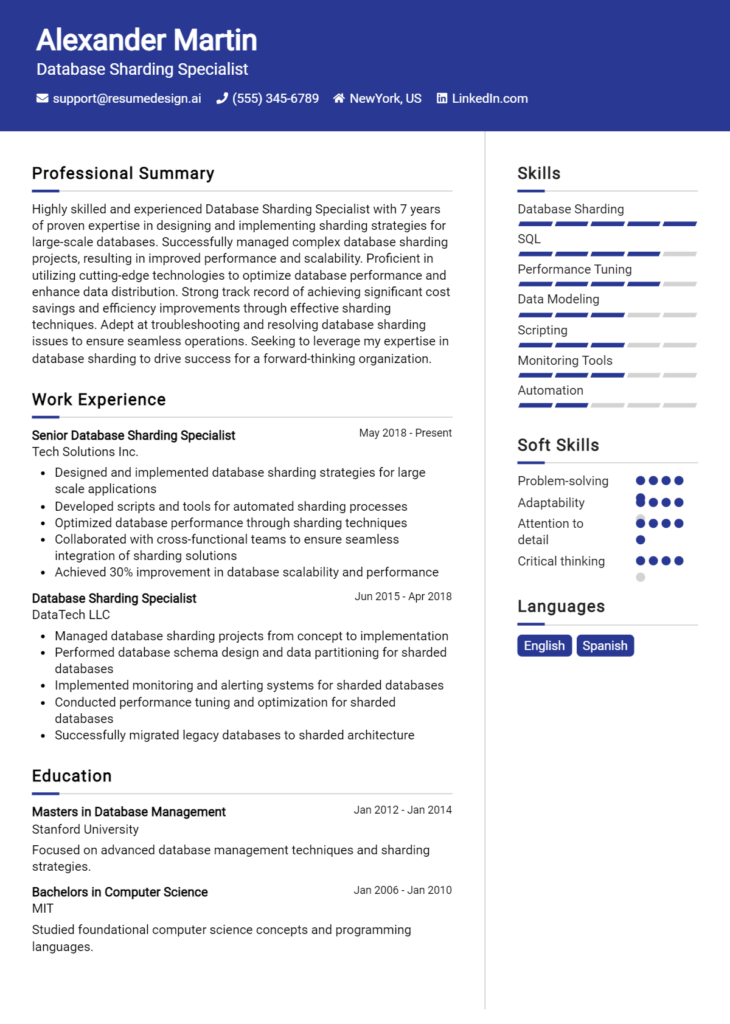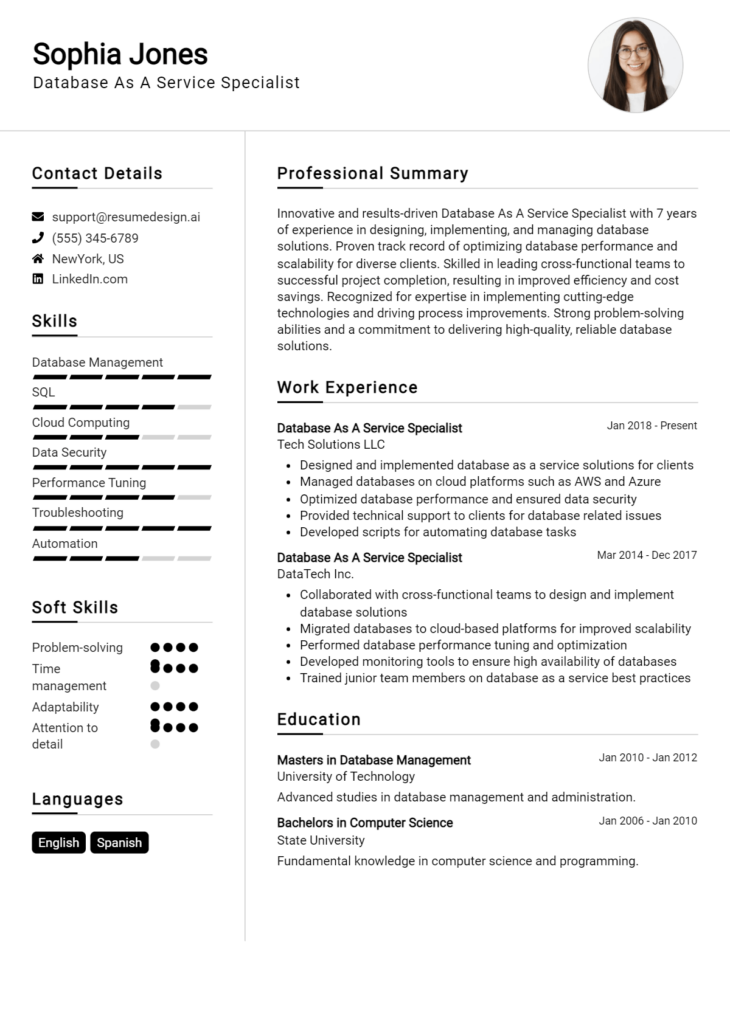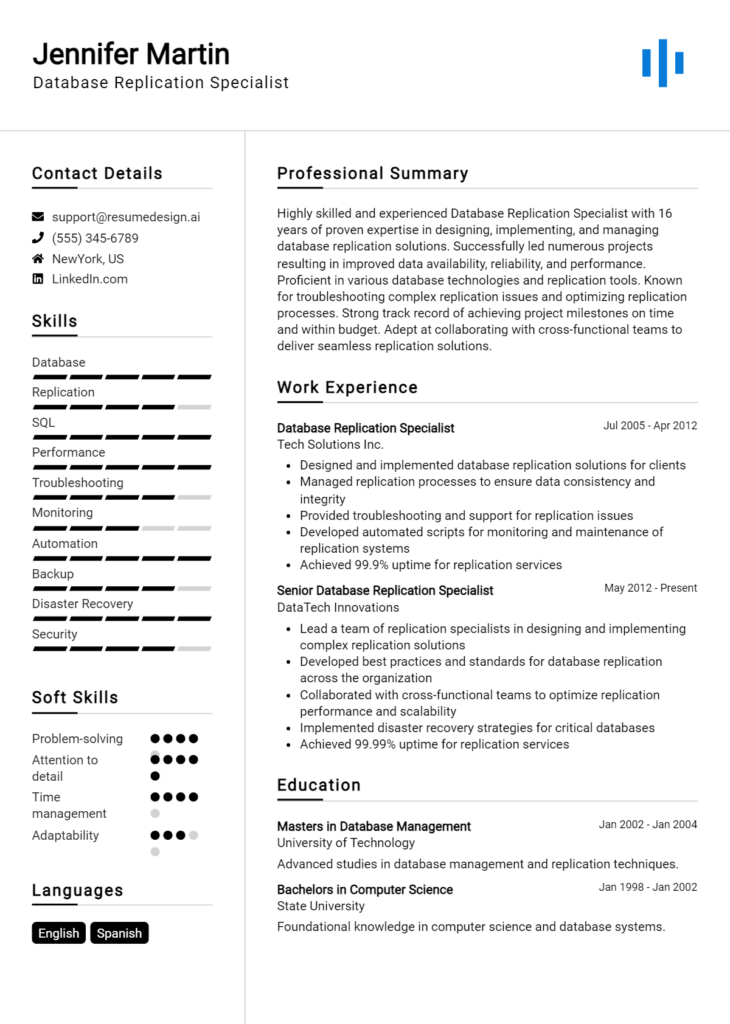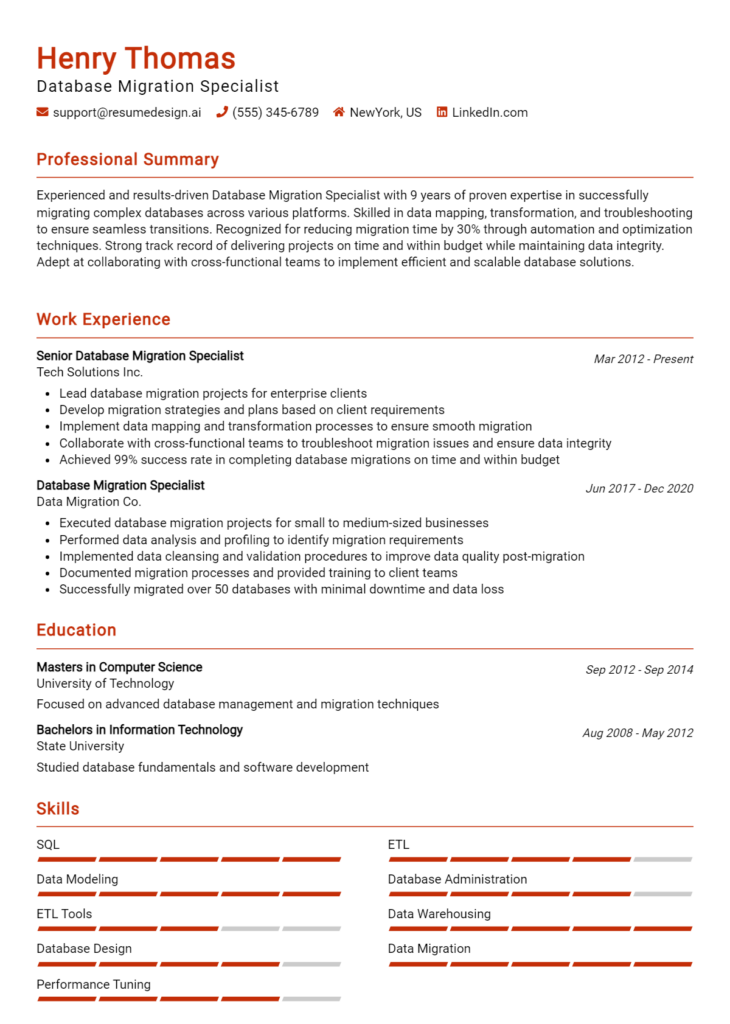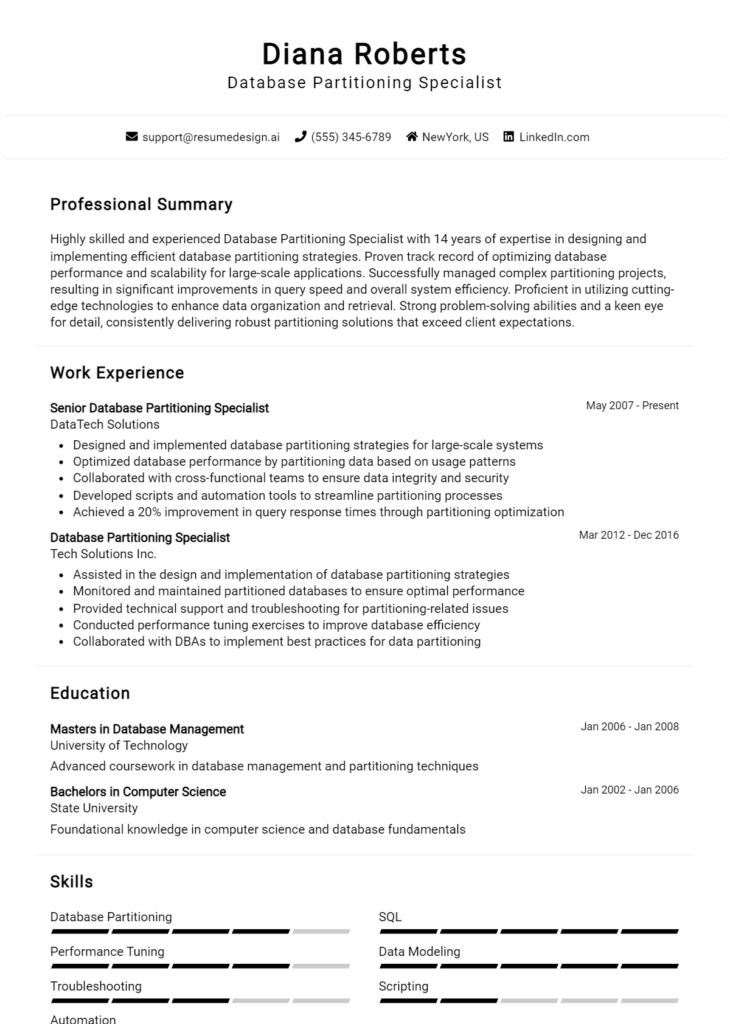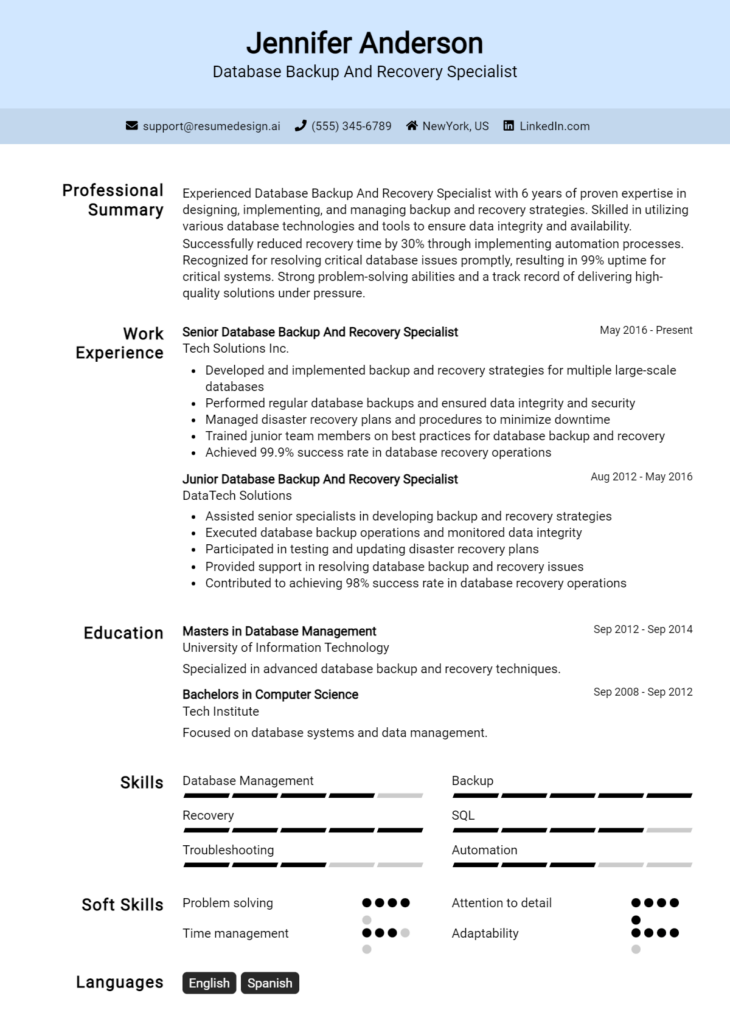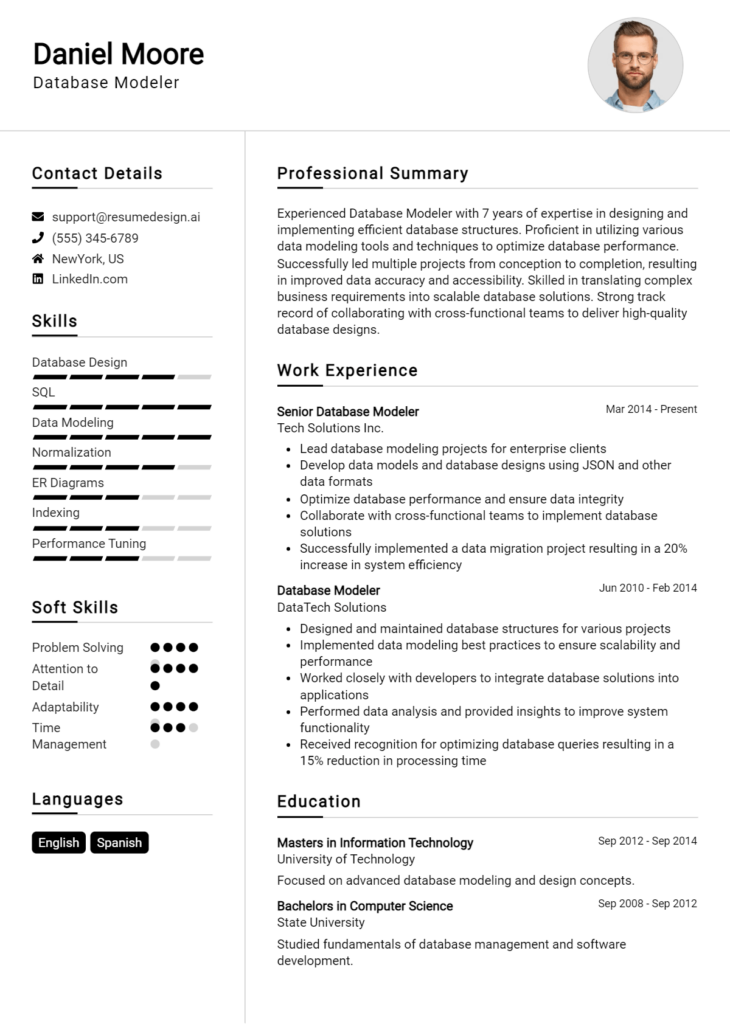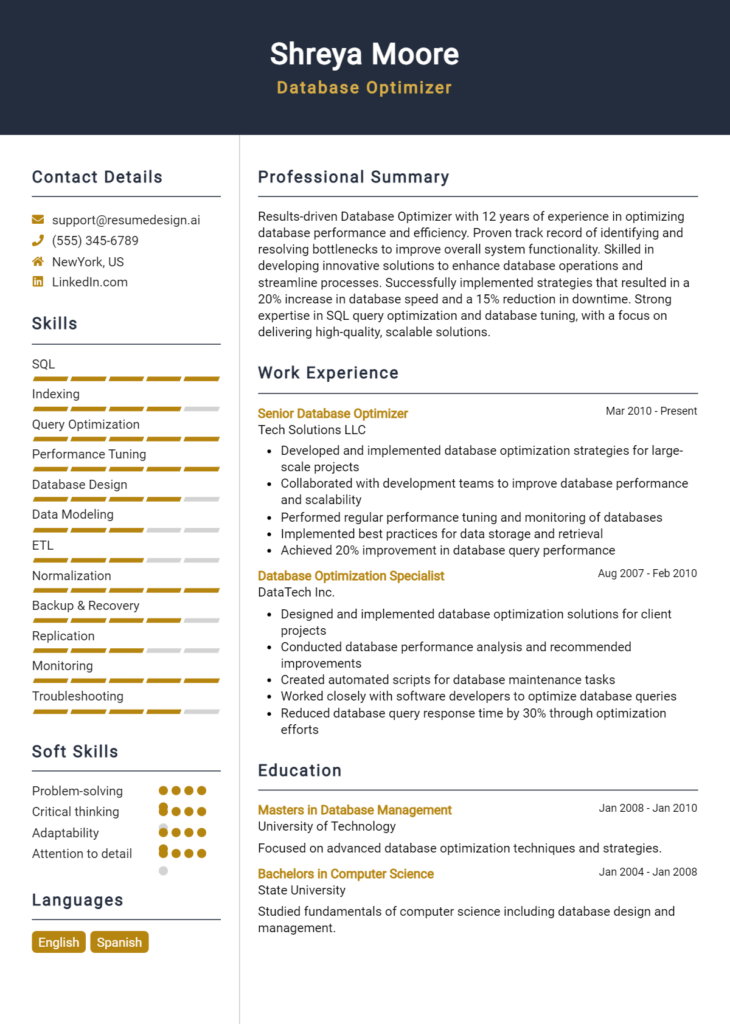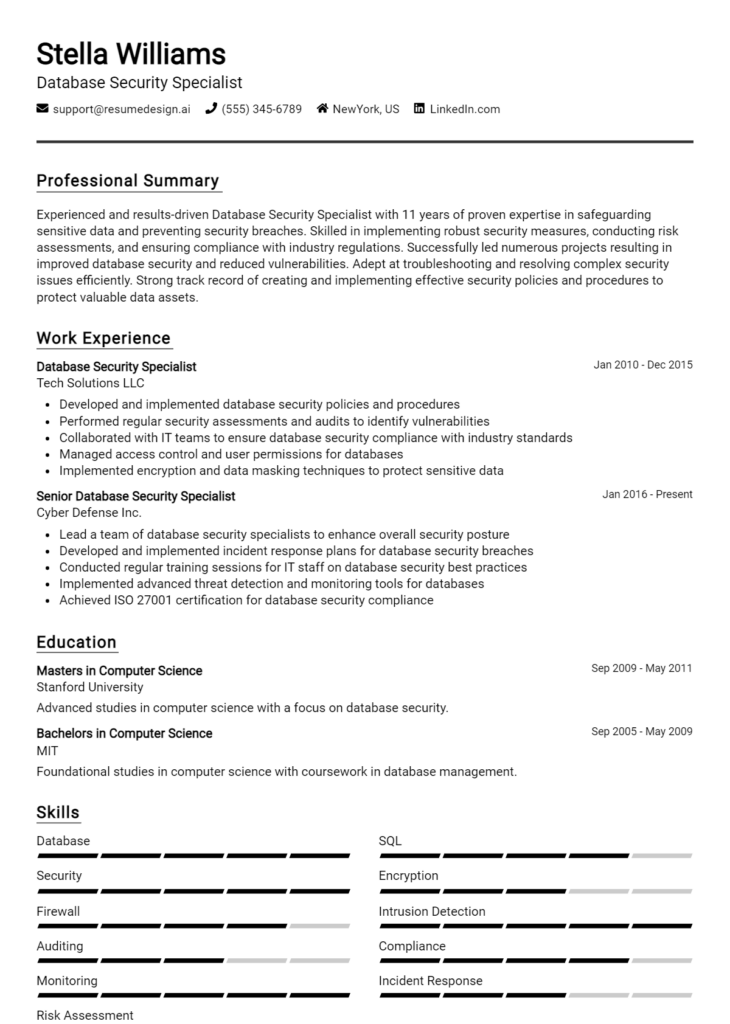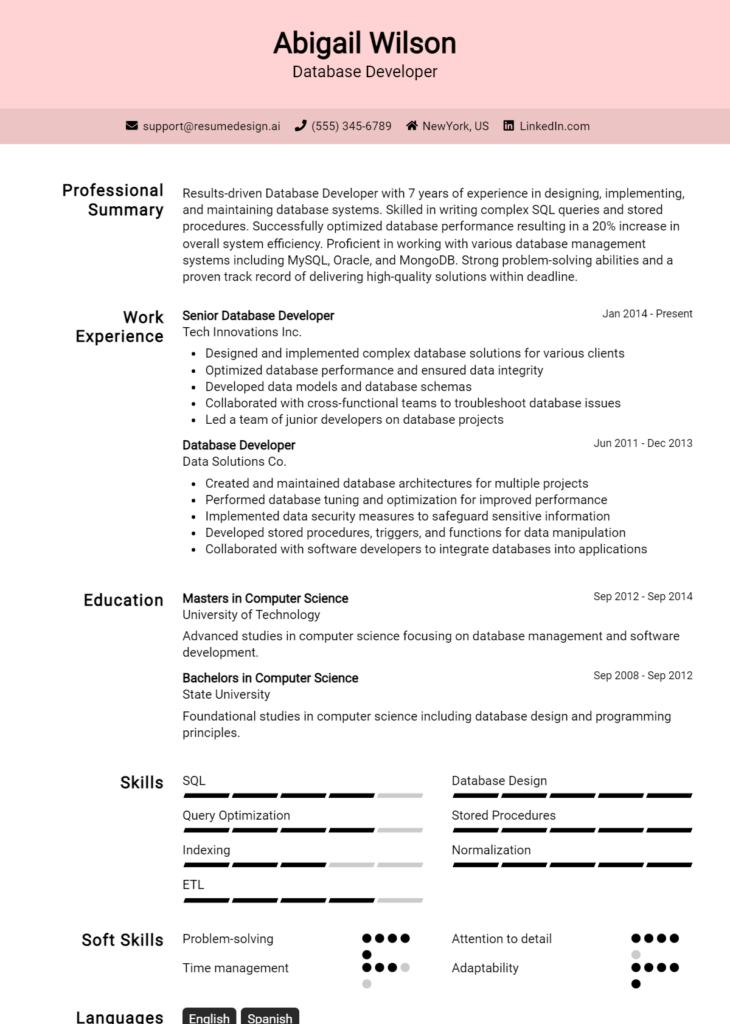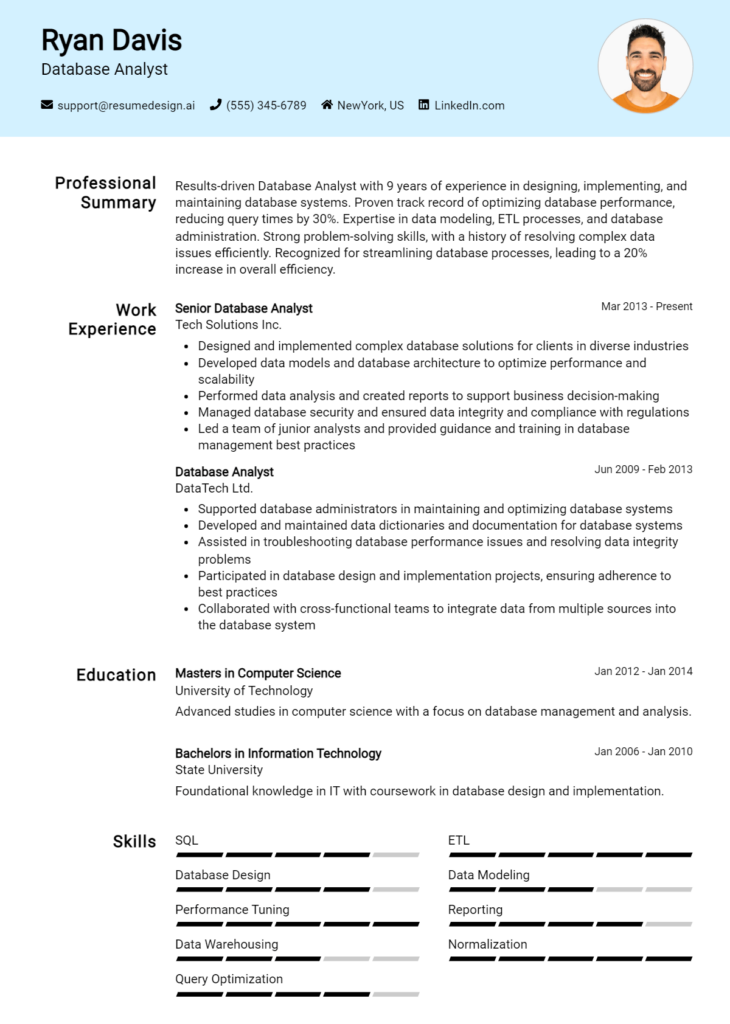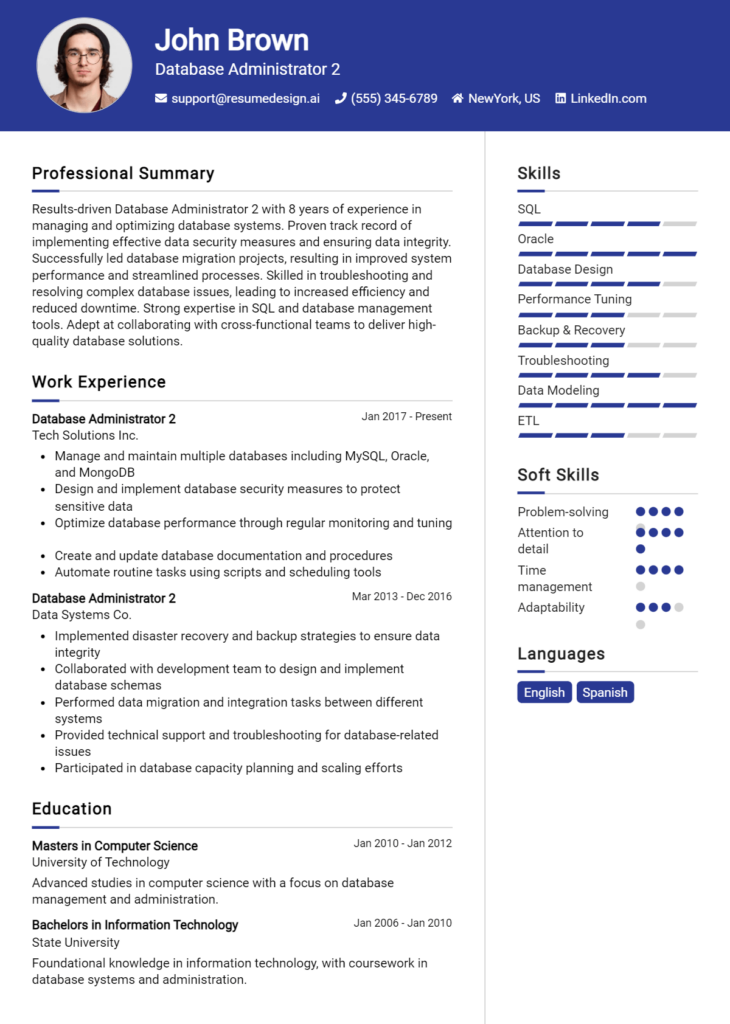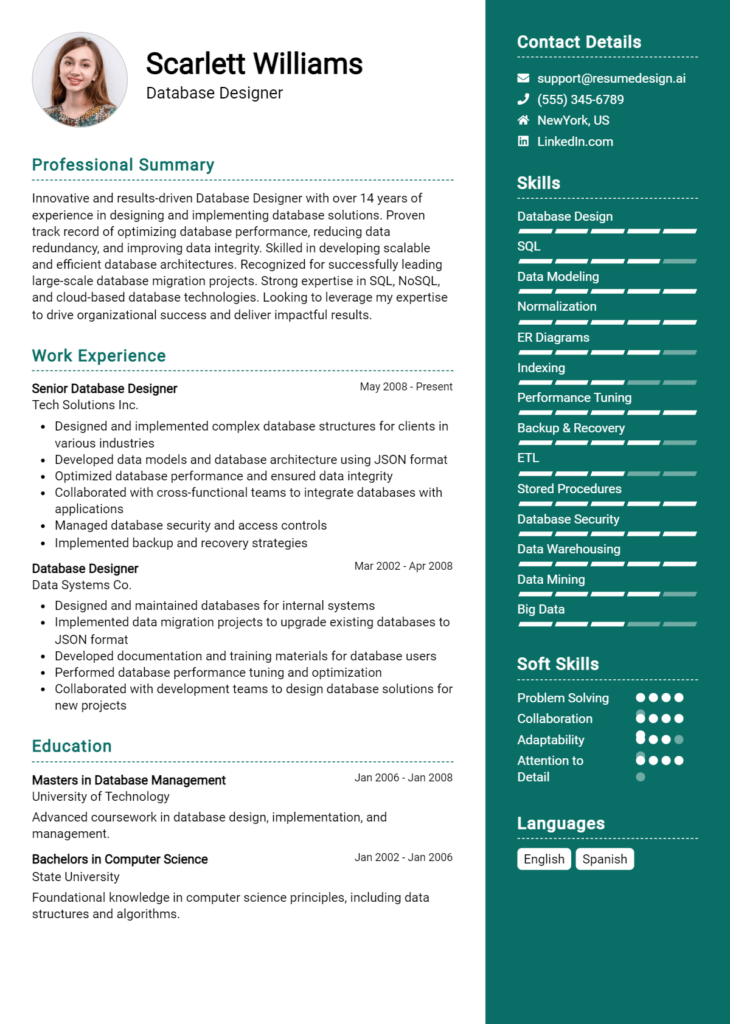Database Architect Core Responsibilities
A Database Architect plays a pivotal role in designing, creating, and managing an organization’s data infrastructure. This professional must possess strong technical skills in database management systems, along with operational and problem-solving abilities to ensure data integrity and accessibility. By bridging various departments like IT, operations, and business analytics, a Database Architect aligns data strategy with organizational goals. A well-crafted resume showcasing these competencies can significantly enhance career prospects and demonstrate value to potential employers.
Common Responsibilities Listed on Database Architect Resume
- Design and implement database structures and models.
- Ensure data security and compliance with regulations.
- Optimize database performance and troubleshoot issues.
- Collaborate with IT and business teams to define data requirements.
- Develop strategies for data storage, backup, and recovery.
- Conduct data analysis and provide insights for decision-making.
- Document database architecture and maintain technical specifications.
- Evaluate and recommend database technologies and tools.
- Lead database migration and integration projects.
- Monitor database health and implement maintenance plans.
- Train and support database users across departments.
High-Level Resume Tips for Database Architect Professionals
In today's competitive job market, a well-crafted resume is essential for Database Architect professionals looking to make their mark. As the first impression a candidate makes on a potential employer, the resume must effectively showcase a blend of technical skills, relevant experience, and notable achievements. A strong resume not only highlights a candidate's qualifications but also conveys their unique value proposition to hiring managers. This guide will provide practical and actionable resume tips specifically tailored for Database Architect professionals, ensuring that your resume stands out in a crowded field.
Top Resume Tips for Database Architect Professionals
- Tailor your resume to the specific job description by using keywords and phrases that align with the requirements outlined in the posting.
- Highlight relevant experience by focusing on past roles that directly relate to database architecture and management.
- Quantify your achievements with metrics, such as the percentage of performance improvement, cost savings, or successful implementations.
- Showcase industry-specific skills, including knowledge of database management systems, data warehousing, and ETL processes.
- Include certifications and training that are relevant to database architecture, such as AWS Certified Database Specialty or Microsoft Azure Database certifications.
- Utilize a clean and organized format that enhances readability, ensuring that key information stands out to potential employers.
- Incorporate a summary statement at the top of your resume that encapsulates your experience and career goals in database architecture.
- List any collaborations with cross-functional teams or leadership roles that demonstrate your ability to work in diverse environments.
- Keep your resume concise, ideally one to two pages, focusing on the most relevant and impactful information.
By implementing these tips, Database Architect professionals can significantly increase their chances of landing a job in this dynamic field. A tailored and polished resume will not only highlight your qualifications but also position you as a competitive candidate ready to contribute effectively to any organization.
Why Resume Headlines & Titles are Important for Database Architect
In the competitive field of database architecture, a well-crafted resume headline or title plays a crucial role in capturing the attention of hiring managers. A strong headline succinctly summarizes a candidate's key qualifications and expertise in a single impactful phrase. It serves as the first impression of the applicant, allowing HR professionals to quickly assess alignment with the job requirements. By being concise, relevant, and tailored to the specific position, a resume headline can effectively set the tone for the entire application, making it essential for candidates to invest time in this critical element of their resumes.
Best Practices for Crafting Resume Headlines for Database Architect
- Keep it concise: Aim for one impactful sentence or phrase.
- Be role-specific: Clearly indicate your expertise in database architecture.
- Highlight key skills: Include specific technical skills or methodologies relevant to the job.
- Use action-oriented language: Choose strong verbs that convey your capabilities.
- Tailor for each application: Customize your headline to align with the job description.
- Showcase accomplishments: If applicable, reference any significant achievements.
- Avoid jargon: Use clear language that is easily understood by all readers.
- Consider keywords: Incorporate industry-specific terms that can help in applicant tracking systems (ATS).
Example Resume Headlines for Database Architect
Strong Resume Headlines
"Results-Driven Database Architect with 10+ Years of Experience in Cloud Solutions"
“Innovative Database Architect Specializing in Data Warehousing and ETL Processes”
“Expert in SQL and NoSQL Databases with Proven Track Record in Performance Optimization”
Weak Resume Headlines
“Database Architect Seeking Opportunities”
“Experienced Professional”
The strong headlines are effective because they are specific, highlighting key skills and experiences that directly relate to the position of a Database Architect. They provide a clear understanding of what the candidate brings to the table, making them stand out in a crowded job market. Conversely, the weak headlines fail to impress as they lack specificity and do not convey any meaningful information about the candidate's qualifications. Generic titles do not help hiring managers identify the unique strengths of an applicant, ultimately leading to missed opportunities for the candidate.
Writing an Exceptional Database Architect Resume Summary
A well-crafted resume summary is crucial for a Database Architect, as it serves as the first impression for hiring managers. A strong summary quickly captures attention by showcasing essential skills, relevant experience, and notable accomplishments that align with the job requirements. This brief yet impactful section should succinctly convey the candidate's qualifications, setting the tone for the rest of the resume. Tailoring the summary to the specific job application not only demonstrates genuine interest but also highlights how the candidate can meet the organization's needs effectively.
Best Practices for Writing a Database Architect Resume Summary
- Quantify achievements: Use numbers and metrics to demonstrate the impact of your work.
- Focus on relevant skills: Highlight skills that are directly applicable to the Database Architect role.
- Tailor the summary: Customize your summary for each job application based on the specific job description.
- Keep it concise: Aim for 3-5 sentences that deliver maximum impact without being lengthy.
- Showcase technology proficiency: Mention specific databases and technologies you are experienced with.
- Highlight problem-solving abilities: Emphasize your capability to design and implement effective database solutions.
- Use action verbs: Start sentences with dynamic verbs to convey your accomplishments effectively.
- Include certifications: If applicable, mention relevant certifications that validate your expertise in database architecture.
Example Database Architect Resume Summaries
Strong Resume Summaries
Accomplished Database Architect with over 8 years of experience in designing high-performance database solutions. Successfully improved query performance by 40% for a leading e-commerce platform, utilizing advanced indexing and partitioning strategies.
Detail-oriented Database Architect skilled in SQL Server and Oracle databases, with a proven track record of reducing data retrieval times by 30%. Led a team in migrating legacy systems to cloud-based solutions, enhancing scalability and reliability.
Results-driven Database Architect with expertise in data modeling and ETL processes. Achieved a 25% increase in data accuracy through the implementation of rigorous validation protocols and automated data cleansing techniques.
Weak Resume Summaries
Experienced Database Architect looking for new opportunities. I know how to work with databases and have completed several projects.
Database professional with various skills in database management. I have worked in different environments and am eager to contribute to a new team.
The strong resume summaries are considered effective because they provide specific, quantifiable outcomes that demonstrate the candidate's impact in previous roles. They highlight relevant skills and experience that align with the Database Architect position, making them memorable and compelling. In contrast, the weak summaries lack detail and specificity, offering a vague overview without showcasing any measurable achievements or relevant skills, which fails to grab the attention of hiring managers.
Work Experience Section for Database Architect Resume
The work experience section of a Database Architect resume is pivotal in demonstrating the candidate's technical proficiency, leadership abilities, and track record of delivering high-quality database solutions. This section serves as a platform to illustrate not only the depth of knowledge in database design and management but also the capacity to collaborate effectively with cross-functional teams. By quantifying achievements and aligning experiences with industry standards, candidates can provide tangible evidence of their contributions and impact, making them stand out in a competitive job market.
Best Practices for Database Architect Work Experience
- Highlight specific technologies and tools used in past projects to demonstrate technical expertise.
- Quantify achievements (e.g., improved database performance by X% or reduced downtime by Y hours) to showcase results.
- Emphasize collaboration by detailing experiences working with developers, data analysts, and IT teams.
- Focus on problem-solving experiences that illustrate your ability to overcome challenges in database architecture.
- Include any leadership roles or mentorship experiences to highlight team management capabilities.
- Align your experiences with industry standards and best practices to show your familiarity with current trends.
- Use action verbs to convey your contributions clearly and dynamically.
- Tailor the work experience to match the job description, emphasizing relevant skills and experiences.
Example Work Experiences for Database Architect
Strong Experiences
- Led a team of 5 database developers to design and implement a new data warehouse solution, resulting in a 30% increase in reporting efficiency.
- Architected a high-availability database system that achieved 99.9% uptime over 12 months, minimizing operational disruptions.
- Implemented database optimization strategies that reduced query response times by 40%, significantly improving application performance.
- Collaborated with cross-functional teams to migrate legacy systems to cloud-based solutions, enhancing data accessibility and security.
Weak Experiences
- Worked on database projects that involved various tasks.
- Participated in team meetings about database architecture.
- Helped with the maintenance of existing databases.
- Assisted in some database migrations.
The examples labeled as 'strong' illustrate specific achievements and quantify the impact of the candidate's work, showcasing their technical leadership and collaboration skills. In contrast, the 'weak' examples lack detail and measurable outcomes, making them less impactful and failing to convey the candidate's true capabilities and contributions in the field of database architecture.
Education and Certifications Section for Database Architect Resume
The education and certifications section of a Database Architect resume is a critical component that illustrates the candidate's academic foundation and commitment to continuous professional development. This section not only highlights relevant degrees and industry-recognized certifications but also showcases specialized training and coursework that enhance the candidate's credibility. By providing this information, candidates can effectively demonstrate their expertise in database management systems, data modeling, and architectural design, thereby aligning themselves closely with the specific requirements of the job role.
Best Practices for Database Architect Education and Certifications
- Prioritize relevant degrees, such as a Bachelor’s or Master’s in Computer Science, Information Technology, or a related field.
- Include industry-recognized certifications, such as Oracle Certified Professional or Microsoft Certified: Azure Database Administrator Associate.
- Detail specialized training or courses that showcase expertise in specific database technologies, methodologies, or tools.
- Use clear and concise language to describe educational qualifications, avoiding unnecessary jargon.
- Highlight certifications that demonstrate continuous learning and staying current with industry trends.
- Be specific about the level and relevance of each certification, especially those that are advanced or specialized.
- Consider adding coursework that directly relates to database architecture, such as data warehousing or big data analytics.
- Keep the section well-organized and easy to read, using bullet points for clarity.
Example Education and Certifications for Database Architect
Strong Examples
- Bachelor of Science in Computer Science, University of California, Berkeley, 2018
- Oracle Certified Professional (OCP) - Database Administrator, 2021
- Master’s in Data Science, Stanford University, 2020
- Coursework in Data Warehousing and ETL Processes, Coursera, 2022
Weak Examples
- Associate Degree in General Studies, City College, 2015
- Certification in Basic Computer Skills, Online Training, 2019
- High School Diploma, Local High School, 2012
- Outdated Microsoft Certified Systems Engineer (MCSE), 2010
The strong examples are considered relevant because they showcase degrees and certifications that align directly with the skills and knowledge necessary for a Database Architect role. They reflect a focus on advanced education and current industry standards. In contrast, the weak examples highlight qualifications that are either too general, outdated, or not sufficiently relevant to the field of database architecture, diminishing the candidate's perceived expertise and suitability for the position.
Top Skills & Keywords for Database Architect Resume
As a Database Architect, possessing the right skills is crucial to effectively design, implement, and manage complex database systems. A well-crafted resume that highlights both technical and interpersonal abilities can significantly enhance a candidate's chances of standing out in a competitive job market. Employers look for a combination of hard and soft skills that demonstrate not only the candidate's technical proficiency but also their ability to collaborate, communicate, and solve problems. By showcasing these skills, candidates can illustrate their capability to contribute meaningfully to their organizations and lead database initiatives successfully.
Top Hard & Soft Skills for Database Architect
Soft Skills
- Problem-solving
- Communication
- Team collaboration
- Critical thinking
- Adaptability
- Attention to detail
- Project management
- Time management
- Creativity
- Leadership
Hard Skills
- Database design and architecture
- SQL proficiency
- Data modeling
- ETL (Extract, Transform, Load) processes
- Performance tuning
- Cloud database technologies (e.g., AWS, Azure)
- NoSQL databases (e.g., MongoDB, Cassandra)
- Data warehousing
- Backup and recovery solutions
- Database security best practices
To further enhance your resume, consider exploring additional skills that can set you apart from other candidates. Additionally, a thorough description of your work experience can provide context for your skills and demonstrate your practical application in real-world scenarios.
Stand Out with a Winning Database Architect Cover Letter
I am writing to express my interest in the Database Architect position at [Company Name], as advertised on [Job Board/Company Website]. With over [X years] of experience in database design, development, and management, I have honed my skills in creating robust data architectures that drive organizational success. My background in both relational and NoSQL databases, combined with my proficiency in SQL, Python, and data modeling tools, positions me as a strong candidate for this role.
In my previous role at [Previous Company Name], I successfully led a team in the redesign of our database infrastructure. This project not only improved the system's performance by 40% but also enhanced data integrity and security. I implemented best practices for database management and optimization, ensuring that our data architecture supported the company's growth and evolving needs. My collaborative approach allowed me to work closely with cross-functional teams to understand their data requirements, resulting in solutions that were both innovative and practical.
I am particularly drawn to [Company Name] because of your commitment to leveraging technology for data-driven decision-making. I am excited about the opportunity to contribute my expertise in designing scalable databases that can handle complex data sets while remaining efficient and accessible. I believe my strategic mindset and passion for database architecture will make a meaningful impact on your team and help [Company Name] achieve its ambitious goals.
Thank you for considering my application. I look forward to the opportunity to discuss how my skills and experiences align with the needs of your organization. I am excited about the prospect of contributing to [Company Name] as a Database Architect and am eager to bring my background in data architecture to your esteemed team.
Common Mistakes to Avoid in a Database Architect Resume
When crafting a resume for a Database Architect position, it's crucial to avoid common pitfalls that can undermine your qualifications and experience. A well-structured resume not only showcases your technical skills but also communicates your value to potential employers. Many candidates inadvertently make mistakes that can detract from their expertise or fail to present their background effectively. Here are some common mistakes to steer clear of:
Vague Job Descriptions: Using generic job titles or descriptions can make it difficult for hiring managers to understand your specific responsibilities and achievements. Be clear and detailed about your role in each position.
Neglecting Relevant Skills: Failing to highlight essential database technologies and methodologies relevant to the role can result in your resume being overlooked. Make sure to list specific skills such as SQL, NoSQL, data modeling, and cloud database solutions.
Overloading with Technical Jargon: While it’s important to demonstrate technical knowledge, using excessive jargon can alienate hiring managers who may not be as familiar with specialized terms. Aim for a balance that conveys expertise without overwhelming the reader.
Ignoring Quantifiable Achievements: Resumes that lack measurable accomplishments can appear less impactful. Whenever possible, include metrics such as performance improvements, cost savings, or the scale of projects you’ve managed.
Formatting Issues: A cluttered or inconsistent format can distract from your qualifications. Ensure that your resume is clean, organized, and easy to read, using consistent fonts and spacing.
Generic Objective Statements: A one-size-fits-all objective statement can come across as insincere. Tailor your objective to reflect your career goals and how they align with the specific role you’re applying for.
Forgetting Soft Skills: While technical skills are paramount for a Database Architect, soft skills such as communication, teamwork, and problem-solving are equally important. Don’t overlook the value of showcasing these attributes.
Lack of Continuous Learning: Failing to mention ongoing education or certifications can imply stagnation. Highlight any recent courses, certifications, or conferences related to database technologies to show your commitment to professional growth.
Conclusion
As we wrap up our discussion on the crucial role of a Database Architect, it's clear that this position demands a blend of technical expertise, strategic planning, and collaborative skills. We’ve explored the various responsibilities, including designing robust database systems, ensuring data integrity, and optimizing performance. Additionally, the importance of staying current with emerging technologies and best practices was highlighted, as this field is constantly evolving.
In light of these insights, it’s essential to reflect on your own qualifications and how effectively they are presented in your resume. A well-crafted resume can significantly impact your job search, showcasing your skills and experiences in a manner that stands out to potential employers.
To enhance your application, consider utilizing the numerous resources available to you. Check out resume templates that can provide a professional layout tailored to the Database Architect role. For a more personalized touch, try the resume builder to create a custom resume that highlights your unique qualifications.
Additionally, reviewing resume examples can give you insight into how successful candidates present their experiences and achievements. Don't forget about the importance of a compelling introduction; our cover letter templates can help you craft a letter that complements your resume and makes a strong case for your candidacy.
Take action today—review your Database Architect resume and leverage these tools to ensure you’re putting your best foot forward in your job search!

